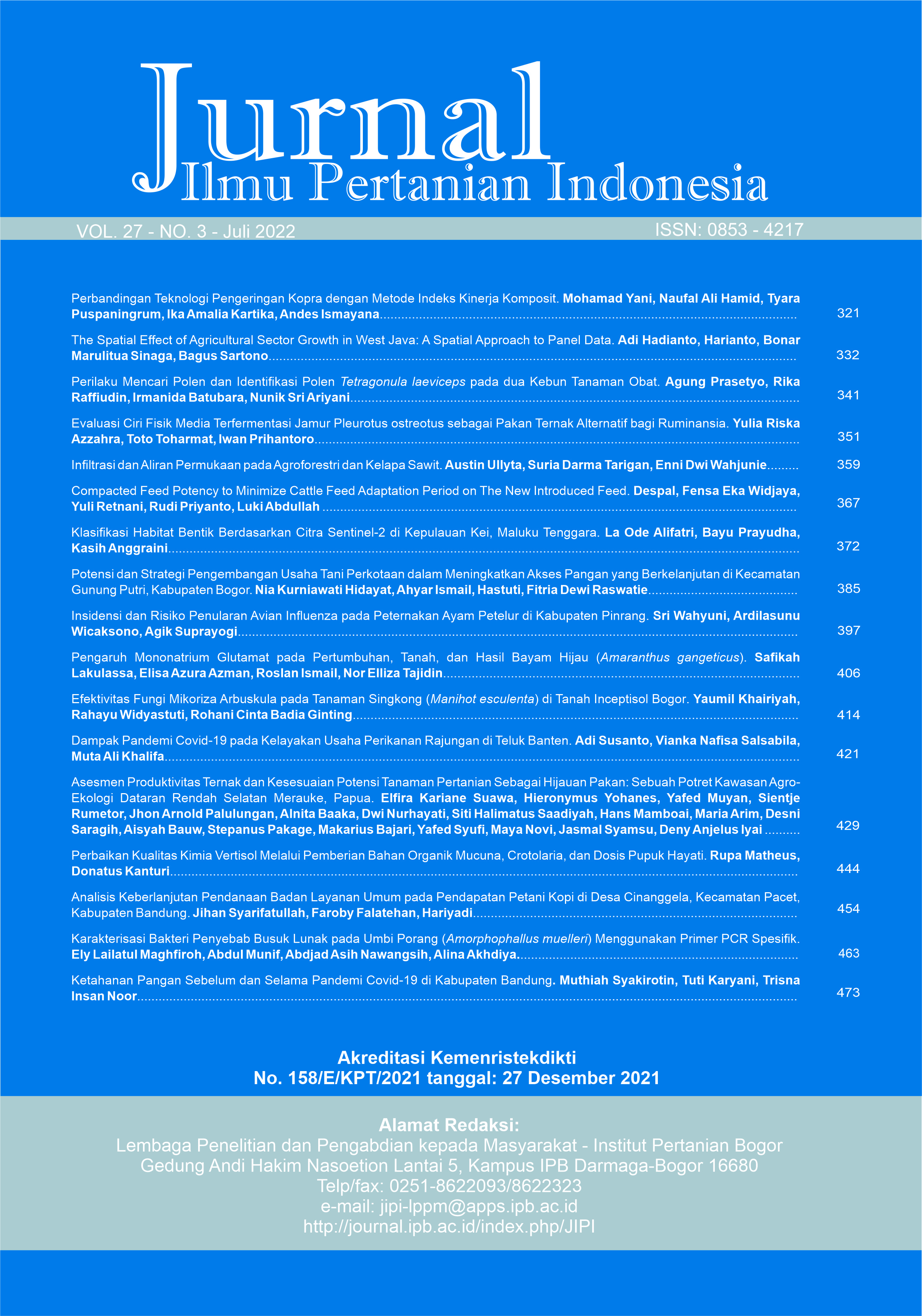Compacted Feed Potency to Minimize Cattle Feed Adaptation Period on The New Introduced Feed
Abstract
Compacted feed such as wafers and pellets is still rarely given to cattle shipping in Indonesia because it requires an adaptation period to the newly introduced feed. This study aimed to observe forage compacted feed potency to minimize the adaptation period of kupang cattle to a new feed with high nutrient content. Two experiments were carried out to observe six feed formulations and four different feed forms. The first experiment was an experiment to determine three of six formulations with the same nutritional content to be tested in the second experiment. The second experiment was to observe four feed forms (wafers, pellets, dry pellets, and cubes) combined with the three best formulations from the first experiment. Six treatments and five replications using 30 cattle and 30 kg of feed were carried out in the first study, while the second one used a randomized factorial design of 4´3 treatments and 5 replications consisting of 60 cattle and 420 kg of feed. The results showed that there was no significant difference between the formulations at the same nutritional level. The highest consumption results were found in the form of wafer followed by cubes, pellets, and dry pellets (P <5%). The conclusion of this study is that the compacted feed in the form of wafers, pellets, and cubes can be used to eliminate the feed adaptation period.
Keywords: feed logistics, compacted feed, kupang cattle, adapting period, feed adaptability
Downloads
References
Beauchemin KA. 1991. Ingestion and mastication of feed by dairy cattle. Veterinary Clinics of North America: Food Animal Practice. 7(2): 439‒463. https://doi.org/10.1016/S0749-0720(15)30794-5
Heazlewood PG, Kelly A, Foot JZ. 1992. Effect of distance of trucking on feeding behaviour and liveweight change of sheep during preshipping feed lotting. In: Proceedings of the Australian Society of Animal Production. Perth, Ausralia, 5th‒9th July 1992
Herrero M, Estrada GE, Thornton PK, Hoogenboom G. 2005. Impact: Integrated Modelling Platform for Mixed Animal-crop Systems: User’s Manual. Kenya: International Livestock Research Institute.
Ibrahim M, Rabah AB, Liman B, Ibrahim NT. 2004. Effect of temperature and relative humidity of Helminthosporium fulvum. Nigerian Journal of Basic and Applied Sciences. 19(1): 127‒129.
Lewis LD. 2013. Feeding and Care of the Horse. John Wiley & Sons, New Jersey (US).
Machado MG, Detmann E, Mantovani HC, Filho SCV, Bento CBP, Marcondes MI, Asuncao AS. 2016. Evaluation of the length of adaptation period for changeover and crossover nutritional experiments with cattle fed tropical forage-based diets. Journal of Animal and Feed Sciences. 222: 132‒148. https://doi.org/10.1016/j.anifeedsci.2016.10.009
Mahyuddin P, Little DA, Lowry JB. 1988. Drying treatment drastically affects feed evaluation and feed quality with certain tropical forage species. Animal Feed Science and Technology. 22: 69‒78. https://doi.org/10.1016/0377-8401(88)90075-2
Malik VK, Singh S. 2004. Effect of temperature and relative humidity on teliospore germination in Ustilago hordei. Journal of Mycology Plant Pathology. 34: 410‒411.
[MLA] Meat and Livestock Australia. 2011. Final Report: Review of Fodder Quality and Quantity in the Livestock Export Trade. North Sydney (AU): Meat and Livestock.
O’Driscoll K, O’Brien B, Gleson D, Boyle L. 2010. Milking frequency and nutritional level affect grazing behavior of dairy cows: a case study. Applied Animal Behaviour Science. 122: 77‒83. https:// doi.org/10.1016/j.applanim.2009.11.014
Piggin C. 2003. The role of leucaena in swidden cropping and livestock production in Nusa Tenggara Timur Province, Indonesia. Agriculture: New Directions for a New Nation, ACIAR Proceedings No 113. Dili, East Timor. 1st‒3rd October 2002.
Sellers J, Loy D. 2007. Supplementation of co-products for cow-calf grazing system – progress report. Iowa State University Animal Industry Report 2007. https://doi.org/10.31274/ans_air-180814-543
Shaver RD. 1997. Nutritional risk factors in the etiology of left displaced abomasum in dairy cows: a review. Journal of Dairy Science. 80(10): 2449–2453. https://doi.org/10.3168/jds.S0022-0302(97) 76197-6
Sonneveld A. 1965. Technical report: Dry matter intake of cattle fed on grass. Grassland Research Institute, California (US).
Talithania D, Salundik, Yani A. 2020. Air quality during journey inter-island on Camara Nusantara 3 Ship. Jurnal Ilmu Produksi dan Teknologi hasil peternakan. 8: 61‒66. https://doi.org/10.29244/ jipthp.8.2.61-66
Thomas M, Poel AFBVD. 2020. Fundamental factors in feed manufacturing: towards a unifying conditioning/pelleting framework. Journal of Animal and Feed Sciences. 268: 114612. https://doi.org/ 10.1016/j.anifeedsci.2020.114612
Van Soest PJ. 2006. Review: rice straw, the role of silica and treatments to improve quality. Animal Feed Science and Technology. 130(3-4): 137‒171. https://doi.org/10.1016/j.anifeedsci.2006.01.023
Warriss PD. 1990. The handling of cattle pre-slaughter and its effects on carcass meat quality. Appl. Applied Animal Behaviour Science. 28(1‒2): 171–186. https://doi.org/10.1016/0168-1591(90) 90052-F
Widjaya FE, Retnani Y, Despal, Abdullah L, Priyanto R. 2018. Regression analysis on physical quality of straw, elephant grass, leucaena, and indigofera leaves for shipping cattle feed. In: The Fourth International Seminar on Animal Industry. IPB International Convention Center, Bogor, Indonesia, 28th‒30th August 2018.
Wirdahayati RB, Bamualim A. 1994. Cattle management systems in Nusa Tenggara, Indonesia. In: Proceedings of the 7th AAAP Animal Science Congress. Bali, Indonesia. 11th‒16th July 1994.
This journal is published under the terms of the Creative Commons Attribution-NonCommercial 4.0 International License. Authors who publish with this journal agree to the following terms: Authors retain copyright and grant the journal right of first publication with the work simultaneously licensed under a Creative Commons Attribution-NonCommercial 4.0 International License. Attribution — You must give appropriate credit, provide a link to the license, and indicate if changes were made. You may do so in any reasonable manner, but not in any way that suggests the licensor endorses you or your use. NonCommercial — You may not use the material for commercial purposes.






















